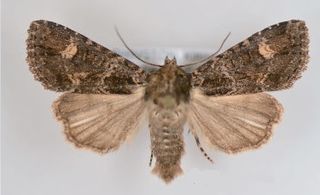
Mythimna separata, the northern armyworm, oriental armyworm or rice ear-cutting caterpillar, is a moth of the family Noctuidae. It is found in China, Japan, South-east Asia, India, eastern Australia, New Zealand, and some Pacific islands. It is one of the major pests of maize in Asia. The species was first described by Francis Walker in 1865.

Plectophila discalis is a moth of the family Xyloryctidae first described by Francis Walker in 1865. It is found in Australia, where it has been recorded from New South Wales, Queensland and Victoria.

Dictyestra is a monotypic moth genus of the family Noctuidae erected by Shigero Sugi in 1982. It contains only one species, Dictyestra dissectus, the angle network armyworm, first described by Francis Walker in 1865. It is found from India to Indochina, Sri Lanka, China, Japan, Sundaland and the Philippines and from Sulawesi to the Moluccas and New Guinea.

Dordura is a monotypic moth genus of the family Noctuidae erected by Frederic Moore in 1882. Its only species, Dordura aliena, was first described by Francis Walker in 1865. It is found in the Indian subregion, Sri Lanka, Myanmar, Thailand, Peninsular Malaysia, Sumatra, Borneo and New Guinea.

Pandesma is a genus of moths in the family Erebidae. The genus was erected by Achille Guenée in 1852.

Mythimna decisissima is a moth of the family Noctuidae first described by Francis Walker in 1856. It is found from India across south-east Asia including Hong Kong, Japan, Taiwan and Australia in Queensland and New South Wales. It is also present in South Africa.

Aseptis binotata, the rusty shoulder knot moth, is a moth of the family Noctuidae. The species was first described by Francis Walker in 1865. It is found widespread in western North America, west of south-central Alberta, Wyoming, and Nebraska. Along the Pacific Coast it occurs from northern Mexico to south-central British Columbia. It can be found from sea level to altitudes over 2000 meters in a variety of habitats from dense forest to shrub desert.

Condica dolorosa is a moth of the family Noctuidae. It is found in the Indo-Australian tropics, including Borneo, Hawaii, Hong Kong, India, Sri Lanka, Taiwan and Queensland in Australia.

The Erebinae are a subfamily of moths in the family Erebidae erected by William Elford Leach in 1815. Erebine moths are found on all continents except Antarctica, but reach their greatest diversity in the tropics. While the exact number of species belonging to the Erebinae is not known, the subfamily is estimated to include around 10,000 species. Some well-known Erebinae include underwing moths (Catocala) and witch moths (Thermesiini). Many of the species in the subfamily have medium to large wingspans, up to nearly 30 cm in the white witch moth, which has the widest wingspan of all Lepidoptera. Erebine caterpillars feed on a broad range of plants; many species feed on grasses and legumes, and a few are pests of castor bean, sugarcane, rice, as well as pistachios and blackberries.

Pinara metaphaea, the pinara moth, is a species of moth of the family Lasiocampidae. It was first described by Francis Walker in 1862. It is known from south-east Australia, including New South Wales and Victoria.

Zalissa catocalina is a moth of the family Noctuidae first described by Francis Walker in 1865. It is found in Papua New Guinea and Australia. In Australia, it is found in or near rainforests in eastern Australia as far south as northern New South Wales.

Armactica columbina is a moth of the family Nolidae first described by Francis Walker in 1865. It is found in the Australian states of New South Wales, Queensland and the north of Western Australia.

Furcula cinerea, the gray furcula moth, is a moth of the family Notodontidae. The species was first described by Francis Walker in 1865. It is found in the United States, southern Canada and the Northwest Territories.

Autoba abrupta is a species of moth of the family Erebidae. It is found in Papua New Guinea, Thailand, and Australia. The species is largely used by the name Eublemma abrupta in Indian and Sri Lankan texts.
Acantholipes trajecta is a species of moth in the family Erebidae first described by Francis Walker in 1865. It is found in South Africa, India, Sri Lanka, and Australia, where it has been recorded from Western Australia, the Northern Territory and Queensland.
Pandesma quenavadi is a moth of the family Noctuidae first described by Achille Guenée in 1852. It has a wide distribution and is found in African countries such as the Democratic Republic of the Congo, Egypt, the Gambia, Kenya, Madagascar, Malawi, Namibia, Somalia, South Africa, Sudan, Tanzania, Uganda, Zambia and Zimbabwe. It is also found in South Asian and South East Asian countries like Sri Lanka, Bangladesh, Taiwan, Myanmar, Thailand, Sumatra, Borneo, Java, the Philippines, Australia and Japan.














